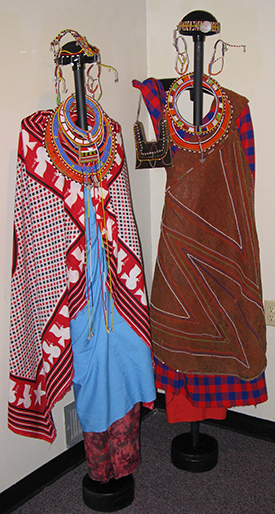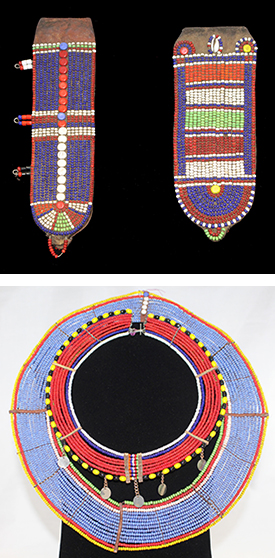Kenya: Create Maasai Accessories
Who are the Maasai?
The Maasai are an ethnic group living in northern, central, and southern Kenya, and northern Tanzania. In 2019, the Maasai population was reported as 1,189,522 in Kenya and about 800,000 in Tanzania.
The Maasai have their own language called Maa. However, most Maasai people also speak Swahili and English, which are the official languages of Kenya and Tanzania.
Internationally, the Maasai are one of the best known East African cultural groups because they live near the many game parks of the African Great Lakes regions. The Maasai invite visitors and tourists into their villages to share their traditions, foods, dress, and arts.
You can learn more about the Maasai here.
Beadwork
One of the main arts of the Maasai are intricate and colorful beaded personal adornment objects: ear flaps, earrings, necklaces, bracelets, belts, headbands. Both Maasai men and women often express their wealth by wearing vivid beaded accessories. Beaded accessories are made by Maasai women as a social activity however, beading is more than that. It is a beautiful expression of feelings, wealth, and a testament of their skill as artisans. Today, these beaded accessories have become a huge source of income for the Maasai.

A Maasai beaded bracelet and earrings from the Lam Musuem collection.
The vibrant colors the Maasai women use in their beadwork have symbolic meaning to the group. The meanings can vary from village to village, but these are some of the most common:

Maasai beaded ear flaps and necklace from the Lam Museum collection
- Red symbolizes unity, bravery, and strength. It draws its meaning from the blood of the cows killed for communal festivals.
- Blue represents the sky and water. It can also symbolize energy and hospitality.
- Green is connected to the olari plant which stands for health. Like the plant, the Maasai grow tall and bountiful. Green can also represent the rich earth which feeds the Maasai people and their animals.
- White symbolizes purity because it is the color of cow’s milk. Sometimes it can also symbolize health because of the nourishment milk provides.
- Yellow represents growth or energy, and orange represents warmth and friendship. Yellow and orange can also signify hospitality. Yellow animal skins and orange gourds filled with milk are typical offerings to guests.
- Black represents the unity of the Maasai people, but it can also symbolize adversity.
You can learn more about Maasai beadwork here.
Let’s create Maasai necklace!
You will need:
• Paper plate
• Scissors
• Stapler or tape
• Crayons, markers, or colored pencils
• Watercolors or craft paint (optional, you can just color with the crayons or markers instead)
• Water
• Cup
• Paintbrushes
• Q-tips
• Optional for more decoration: beans, noodles, sequins, beads, stickers
